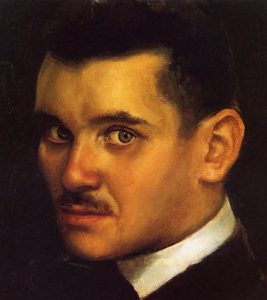JOSÉ AGUIAR GARCÍA
Although born in Cuba in 1895 he can be considered a Gomero painter and, above all of Agulo, the place of origin of his family and where he lived during his childhood, since he was even baptized in the parish of San Marcos in 1897.
José Aguiar is one of the most important characters of Canarian painting and one of the highest representatives of Spanish muralism of the 50s and 60s of the twentieth century.
In 1897 his parents decided to return from Cuba and settle in Agulo, where Aguiar went to school until in 1906 he moved to La Laguna to study at its secondary school. At this time, the young man came into contact with other students from La Gomera and members of the later Canarian culture of the 30s of the twentieth century. One of these students is the Agulense writer Pedro Bethencourt Padilla, for whom he will make the designs of his poem Salterio published in Madrid in 1920.
In 1914 Aguiar traveled to Madrid to study law, an idea that he quickly abandoned to, in 1916, studied at the School of Fine Arts informally and unregulated, with master José Pinazo, famous painter winner of the gold medal in the Exhibition 1915 National National.
Aguiar settled in Madrid where she married and had 2 children; a boy and a girl.
Immersed in artistic production participated in the National Exhibitions of Fine Arts; being the Third Medal in Madrid in 1926 and Gold Medal in Barcelona in 1929, normally presenting works of large format and certain island regionalist content.
In 1930, after achieving his Gold Medal, he traveled to Italy through a scholarship granted by the Cabildo de La Gomera to improve his training and in 1934 to deepen the study of Renaissance mural painting.
It was on these dates that he received one of the first important commissions in Tenerife, which led him to the realization of El Friso Isleño for the Hall of the new Casino of Santa Cruz de Tenerife, consisting of a large mural painting with the techniques of encaustics. Subsequently, he received numerous commissions from the Government for institutions in Madrid and the Canary Islands, including one of the first portraits of Francisco Franco. However, he also suffered some setbacks for his membership in Freemasonry between 1930 and 1932, and was interrogated in 1943.
Currently, new perspectives on his work have been able to correct his figure, style, aesthetics and plastic intention, often underestimated by the historiography of Canarian art. Thanks to the documentation kept in the National Civil War Archive in Salamanca, you can reread the production of the artist differently. José Aguiar also suffered the consequences of the Regime, and even if he worked for The Autarchy from within it, he therefore reproduced the anguish of the post-war Human Being and thus becomes subversively encrypting. The painter Agulense criticized, from the official practice of his exercise, and with some hermetism, the infeasibility of a life with the absence of Democracy and Freedom in Spain since 1936.




